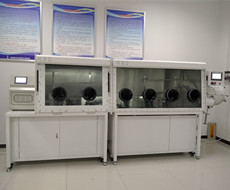- Home
- Product Center
- Specific Process Series
- Rapid annealing
- Glove box plus high temperature furnace, etc
Product Center
Phone: 400-000-3746
- Tube furnace
- Muffle furnace
- CVD system
- Hydrogen reduction furnace
- Rotary furnace
- Ultra-high temperature sintering furnace
- Induction heating furnace
- Molten salt furnace
- Lift,Shaft,Crucible Furnace
- Hardening furnace
- Specific Process Series
- Drying Box Series
- Ball-milling mixer
- Tablet press series
- Vacuum system
- Gas supply system
- Industrial furnace
- Related Accessories
- Crystals and targets
Contact Us
Sale Service: 0371-6320 2801
0371-6320 2805
After-sales service: 0371-6320 2805
MR. CAI: 181-0371-5723
Mr.Gao: 188-3829-0747
Ms.Huang: 188-3829-0748
Email : nbd@nbdkj.com
Address:8# zhuyuan, Xinhua subdistrict, Xinzheng, Zhengzhou, China
Glove box plus high temperature furnace, etc
Release time: 2024-07-10 03:41:12 Number of views: 126


Equipment introduction:
The glove box is a laboratory device that fills the box with high purity inert gases and circulates to filter out the active substances. Also known as vacuum glove box, inert gas protection box, etc.
The main function is to remove O2, H2O and organic gases. Widely used in water-free, oxygen-free, dust-free ultra-pure environment, such as: lithium-ion batteries and materials, semiconductors, supercapacitors, special lamps, laser welding, brazing, material synthesis, OLED, MOCVD, etc. It also includes biological applications, such as anaerobic bacteria culture, cell hypoxic culture, etc.

Equipment introduction:
The glove box is a laboratory device that fills the box with high purity inert gases and circulates to filter out the active substances. Also known as vacuum glove box, inert gas protection box, etc.
The main function is to remove O2, H2O and organic gases. Widely used in water-free, oxygen-free, dust-free ultra-pure environment, such as: lithium-ion batteries and materials, semiconductors, supercapacitors, special lamps, laser welding, brazing, material synthesis, OLED, MOCVD, etc. It also includes biological applications, such as anaerobic bacteria culture, cell hypoxic culture, etc.
Configuration details
Glove box + series products
Equipment features: | ||||||||||||||||||||||||||||||||||
Major component | ||||||||||||||||||||||||||||||||||
Control system
| ||||||||||||||||||||||||||||||||||
Transition cabin construction | ||||||||||||||||||||||||||||||||||
Replacement of activated carbon | ||||||||||||||||||||||||||||||||||
Electrical Spec | AC220V 1.5KW | |||||||||||||||||||||||||||||||||
Preparation and inspection before use | 1. Prepare sufficient high purity working gas (please refer to Table 1 for gas specifications)
| |||||||||||||||||||||||||||||||||
caution | 1. Personnel shall not use the glove box without training; | |||||||||||||||||||||||||||||||||
推荐产品
Light duty melting furnace

Production vacuum atmosphere pendulum rotary sintering furnace 1200℃

Glove box plus high temperature furnace, etc

Ion sputtering coating instrument

